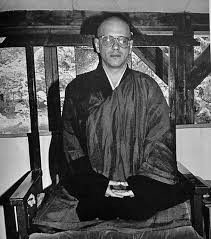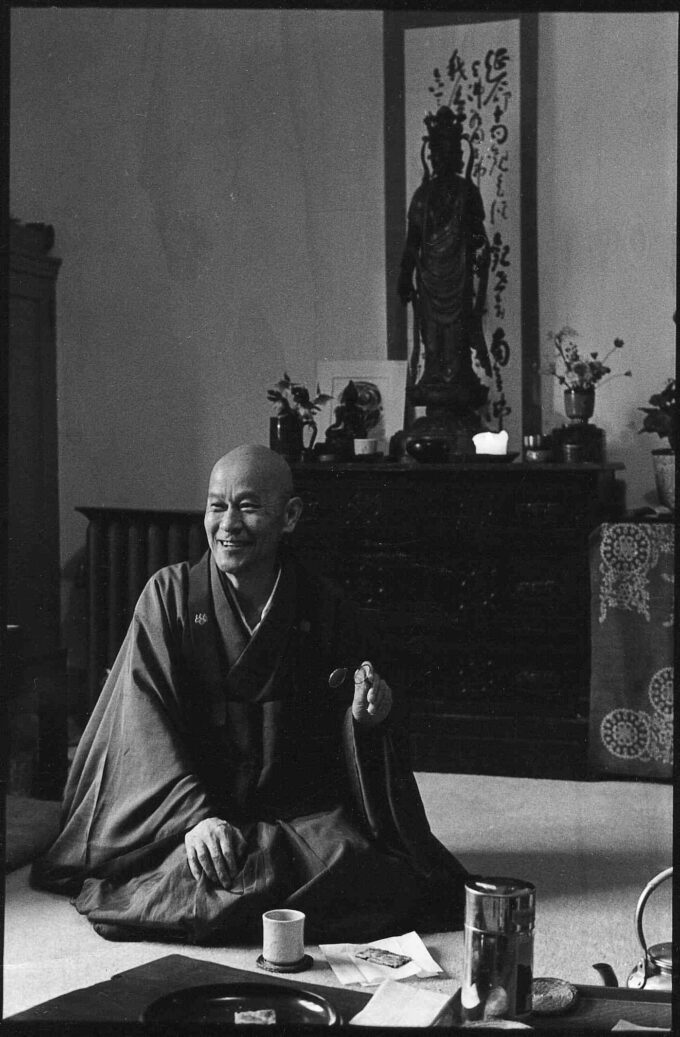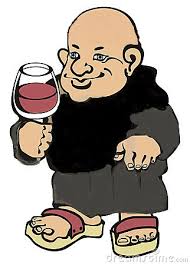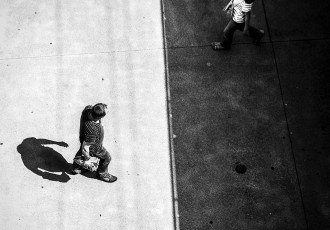Etienne Mokusho Zeisler, the treasury of the Great Sangha of master Deshimaru, died on the night of the 7th to the 8th of June, 1990, at the age of 44. Zeisler was one of Deshimaru´s principle disciples. He was Deshimaru´s translator and teacher until Deshimaru´s death in 1982. After master Deshimaru’s death, Zeisler became the president of the Zen Dojo in Paris. Etienne Zeisler was an example of simplicity in his manners as well as in his determination in what is fundamental. He was bearing no special interest in being a master, but after the death of Deshimaru he became his natural successor in the Dharma.
Zeisler was born in in 1946 in Hungary, and when he was three years old his family moved to France. He studied law, and in 1967 he met Taisen Deshimaru, who had recently arrived in France from Japan. Etienne Zeisler was among the first persons to practice with Deshimaru in France. And 15 years later, at Deshimaru’s death, Zeisler assumed a principle role in continuing his master’s mission in Europe. A task which lasted until his own death. Zeisler received shijo, certification, from Niwa Roshi, who was, at that time, the abbot of Eiheiji.
Zeisler authored a number of translations and commentaries of fundamental Zen-Buddhist texts: The song of the silent illumination of Wanshi, the Tenzo Kyokun – the teaching to the cook – of Dogen, The song of the straw hut of master Sekito. These texts are true examples of the manifestation of his understanding and of his teaching approach. Zeisler also led numerous sesshins, where he transmitted the teachings that he has received. He assumed the heritage of Deshimaru Roshi by being one of the first European teachers to speak by his own voice, and spread the seeds of the dharma with a total generosity.
He transmitted the importance and the rigor of the rules of Dogen, the necessity of preserving the dojo as the place of practice-realization of the awakening, by always putting zazen before any other consideration. His personality and his teaching left a deep trace at the bottom of the mind for those who knew him. His teachings are transmitted and cherished in the Mokusho Zen sangha, founded in Hungary and Romania, following his vows.
In the Ju Undo Shiki, it is how to practice in the dojo. Why are we practicing zazen? How to realize the true Way? How to do to understand ourselves? Shakyamuni Buddha says: “The study, the observance of the precepts and the practice of zazen are unable to extinguish our desires. Although these practices are meritorious, it is difficult to have faith in them.” In the dojo, a law, a rule exists. You can read the rules of the dojo of Paris in the cloakroom. When Sensei wrote them, he was inspired by the rules of Dogen, the Ju Undo Shiki. In the dojo, the law, the rule is absolute. It is not possible to change it. Even if the Parliament votes a law, it cannot modify the rule of the dojo, this rule is ho, the dharma. To follow the rule of the dojo is to follow the law which exists from millions of years: namely not to follow our ego, our personal ideas. If we follow only our categories, if we listen only to our front brain, to our personal consciousness, even if we study, even if we observe the precepts, even if we practice zazen, it is totally useless, inefficient. Understanding us, understanding our ego, means abandoning the ego, forget about the ego. If we abandon the ego, ho, the law exists, and the Way can be expressed, actualized. Ho – the law – has been passed from Buddha on all masters, on all patriarchs. Where the law does not exist, the Way cannot appear. This practice is not difficult. It is the dojo here and now. It is to follow the others, not to disturb the others. Our life must follow the law. Everything is important in this dojo: how to enter, how to walk, how to sit, how to breathe. The tiniest things become a question of life or death. It is difficult to believe in the law, in the rule. But to have faith means nonduality. It is not an action of our ego or of our understanding. The posture of zazen itself is Buddha. To believe in that is the secret of Zen. If we abandon the ego, we can believe that the posture of zazen itself is Buddha, that the practice here and now is the satori. When the law exists, the Way is actualized. This is the true practice in the dojo and the true satori without any stains.
During zazen, you can see yourselves, look inside of yourself and see your illusions. The purer zazen becomes, transparent, the easier it is for you to see your illusions. Zazen is like a house made of glass; it is not like a castle nor like a cheap rent, not even like a Japanese house. Zazen is completely transparent. And, this practice of zazen shines in all directions, north, south, top, down, and also in the future, the past, the present. If we think to the worldly life, to our personal affairs, it is always before, after, later. But in the moment of now, only the Way exists, only the truth exists.
photo credit:MokushoZenHouse
video:interview
video: koan




